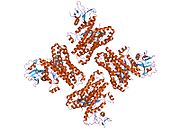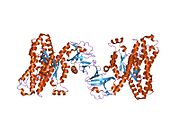RhoC
RhoC (Ras homolog gene family, member C) is a small (~21 kDa) signaling G protein (more specifically a GTPase), and is a member of the Rac subfamily of the family Rho family of GTPases.[5] It is encoded by the gene RHOC.[6]
Mechanism and function
[edit]It is prenylated at its C-terminus, and localizes to the cytoplasm and plasma membrane. It is thought to be important in cell locomotion. It cycles between inactive GDP-bound and active GTP-bound states and function as molecular switches in signal transduction cascades. Rho proteins promote reorganization of the actin cytoskeleton and regulate cell shape and motility. RhoC can activate formins such as mDia1 and FMNL2 to remodel the cytoskeleton.[7][8][9]
Overexpression of RhoC is associated with cell proliferation and causing tumors to become malignant.[10] It causes degradation and reconstruction of the Extracellular Matrix (ECM) which helps cells escape the tissue they are currently in. It enhances cell motility giving it the ability to become invasive.[11] It has been found to have a direct relationship to advanced tumor stage and metastasis, with increases in stage being related to increases in RhoC expression.[12] RhoC-deficient mice can still develop tumors but these fail to metastasize, arguing that RhoC is essential for metastasis.[13] It has also been found to enhance the creation of angiogenic factors such as VEGF, which is necessary for a tumor to become malignant.[12][14] In a study by Vega,[15] RhoC was knocked out which resulted in cells spreading out wide in all directions. When RhoC was disabled, the cell's abilities to move in a specific direction and migrate was impaired. It also reduced the cell's speed of movement, because it was difficult, and sometimes impossible, to polarize the cell.
Associated Signaling Pathways
[edit]RhoC expression has been associated with several signaling pathways and effectors. Here is a list of the ones found so far:
- IQGAP1 (IQ-domain GTP-ase Activating Protein): an effector of RhoC to enhance expression of cyclin E and cyclin D1. This resulted in cells being promoted to enter S phase more rapidly [16]
- ROCK-1 [12][17]
- MMP9: necessary for ECM regulation[12]
- FMNL3: a Formin downstream target, which is used to regulate where Rac1 is active [15]
- MAPK pathway: upregulating VEGF, Basic fibroblastic growth factors, and interleukins 6 and 8 expression [14][18]
- Notch1 [14]
- PI3K/AKt pathway: Proliferation and invasiveness [14][19]
- Pyk2: metastasis [14][20]
Types of Cancer RhoC has been studied in
[edit]RhoC has been found to be overexpressed in:
- Lung Cancer [11]
- Gastric Cancer [16]
- Ovarian cancer [12]
- Breast Cancer [18][21]
- Hepatocellular Cancer [22]
- Pancreatic Cancer [12]
- Colorectal Cancer [23]
- Cancer of the Urogenital System [12]
- Melanoma [12]
- Prostate Cancer [20]
- Cervical Carcinoma [14]
Potential Therapies
[edit]RhoC small interfering RNA (siRNA) have been used in studies to successfully inhibit proliferation of some invasive cancers [16][23] RhoC can be used as a biomarker for judging the metastatic potential of tumors[21][24] One study used "recombinant adenovirus mediated RhoC shRNA in tandem linked expression" to successfully inhibit RhoC [23] It has been found that RhoC expression is not important for embryogenesis but it is only important for metastasis, which would make it a good target for treatments.[14] A RhoC targeted therapy (RV001 by RhoVac) is currently tested in prostate cancer in an ongoing clinical phase 2b program in the US and Europe. Results are expected mid 2022 (Reference: https://clinicaltrials.gov/ct2/show/NCT04114825)
References
[edit]- ^ a b c GRCh38: Ensembl release 89: ENSG00000155366 – Ensembl, May 2017
- ^ a b c GRCm38: Ensembl release 89: ENSMUSG00000002233 – Ensembl, May 2017
- ^ "Human PubMed Reference:". National Center for Biotechnology Information, U.S. National Library of Medicine.
- ^ "Mouse PubMed Reference:". National Center for Biotechnology Information, U.S. National Library of Medicine.
- ^ Ridley A. (2006). "Rho GTPases and actin dynamics in membrane protrusions and vesicle trafficking". Trends Cell Biol. 16 (10): 522–9. doi:10.1016/j.tcb.2006.08.006. PMID 16949823.
- ^ "Entrez Gene: RHOC ras homolog gene family, member C".
- ^ Kitzing TM, Wang Y, Pertz O, Copeland JW, Grosse R (April 2010). "Formin-like 2 drives amoeboid invasive cell motility downstream of RhoC". Oncogene. 29 (16): 2441–8. doi:10.1038/onc.2009.515. PMID 20101212. S2CID 25556221.
- ^ Jaffe AB, Hall A (2005). "Rho GTPases: Biochemistry and Biology". Annual Review of Cell and Developmental Biology. 21: 247–69. doi:10.1146/annurev.cellbio.21.020604.150721. PMID 16212495.
- ^ Vega FM, Ridley AJ (2008). "Rho GTPases in Cancer Cell Biology". FEBS Letters. 582 (14): 2093–2101. Bibcode:2008FEBSL.582.2093V. doi:10.1016/j.febslet.2008.04.039. PMID 18460342.
- ^ Horiuchi A, Imai T, Wang C, Ohira S, Feng Y, Nikaido T, Konishi I (June 2003). "Up-Regulation of Small GTPases, RhoA and RhoC, Is Associated with Tumor Progression in Ovarian Carcinoma". Laboratory Investigation. 83 (6): 861–870. doi:10.1097/01.LAB.0000073128.16098.31. PMID 12808121. S2CID 22119772.
- ^ a b Ikoma T, Takahashi T, Nagano S, Li YM, Ohno Y, Ando K, Fujiwara T, Fujiwara H, Kosai K (February 2004). "A Definitive Role of RhoC in Metastasis of Orthotopic Lung Cancer in Mice". Clinical Cancer Research. 10 (3): 1192–1200. doi:10.1158/1078-0432.ccr-03-0275. PMID 14871999.
- ^ a b c d e f g h Zhao Y, Zhi-hong Z, Hui-mian X (2010). "RhoC Expression Level Is Correlated with the Clinicopathological Characteristics of Ovarian Cancer and the Expression Levels of ROCK-I, VEGF, and MMP9". Gynecologic Oncology. 116 (3): 563–71. doi:10.1016/j.ygyno.2009.11.015. PMID 20022093.
- ^ Hakem A, Sanchez-Sweatman O, You-Ten A, Duncan G, Wakeham A, Khokha R, Mak TW (September 2005). "RhoC is dispensable for embryogenesis and tumor initiation but essential for metastasis". Genes Dev. 19 (17): 1974–9. doi:10.1101/gad.1310805. PMC 1199568. PMID 16107613.
- ^ a b c d e f g Srivastava S, Ramdass B, Nagarajan S, Rehman M, Mukherjee G, Krishna S (2010). "Notch1 Regulates the Functional Contribution of RhoC to Cervical Carcinoma Progression". British Journal of Cancer. 102 (1): 196–205. doi:10.1038/sj.bjc.6605451. PMC 2813755. PMID 19953094.
- ^ a b Vega FM, Fruhwirth G, Ng T, Ridley AJ (2011). "RhoA and RhoC Have Distinct Roles in Migration and Invasion by Acting through Different Targets". The Journal of Cell Biology. 193 (4): 655–65. doi:10.1083/jcb.201011038. PMC 3166870. PMID 21576392.
- ^ a b c Wu Y, Tao Y, Chen Y, Xu W (2012). "RhoC Regulates the Proliferation of Gastric Cancer Cells through Interaction with IQGAP1". PLOS ONE. 7 (11): e48917. Bibcode:2012PLoSO...748917W. doi:10.1371/journal.pone.0048917. PMC 3492142. PMID 23145020.
- ^ Genda T, Sakamoto M, Ichida T, Asakura H, Kojiro M, Narumiya S, Hirohashi S (1999). "Cell Motility Mediated by Rho and Rho-Associated Protein Kinase Plays a Critical Role in Intrahepatic Metastasis of Human Hepatocellular Carcinoma". Hepatology. 30 (4): 1027–36. doi:10.1002/hep.510300420. PMID 10498656. S2CID 35864555.
- ^ a b Van Golen KL, Bao LW, Pan Q, Miller FR, Wu ZF, Merajver SD (2002). "Mitogen Activated Protein Kinase Pathway Is Involved in RhoC GTPase Induced Motility, Invasion and Angiogenesis in Inflammatory Breast Cancer". Clinical & Experimental Metastasis. 19 (4): 301–11. doi:10.1023/A:1015518114931. hdl:2027.42/42584. PMID 12090470. S2CID 211284.
- ^ Sun HW, Tong SL, He J, Wang Q, Zou L, Ma SJ, Tan HY, Luo JF, Wu HX (2007). "RhoA and RhoC -siRNA Inhibit the Proliferation and Invasiveness Activity of Human Gastric Carcinoma by Rho/PI3K/Akt Pathway". World Journal of Gastroenterology. 13 (25): 3517–22. doi:10.3748/wjg.v13.i25.3517 (inactive 3 December 2024). PMC 4146790. PMID 17659701.
{{cite journal}}: CS1 maint: DOI inactive as of December 2024 (link) - ^ a b Iiizumi M, Bandyopadhyay S, Pai SK, Watabe M, Hirota S, Hosobe S, Tsukada T, et al. (2008). "RhoC Promotes Metastasis via Activation of the Pyk2 Pathway in Prostate Cancer". Cancer Research. 68 (18): 7613–20. doi:10.1158/0008-5472.CAN-07-6700. PMC 2741300. PMID 18794150.
- ^ a b Kleer CG, Griffith KA, Sabel MS, Gallagher G, van Golen KL, Wu ZF, Merajver SD (2005). "RhoC-GTPase Is a Novel Tissue Biomarker Associated with Biologically Aggressive Carcinomas of the Breast". Breast Cancer Research and Treatment. 93 (2): 101–10. doi:10.1007/s10549-005-4170-6. hdl:2027.42/44231. PMID 16187229. S2CID 9215922.
- ^ Wang W, Wu F, Fang F, Tao Y, Yang L (2008). "RhoC Is Essential for Angiogenesis Induced by Hepatocellular Carcinoma Cells via Regulation of Endothelial Cell Organization". Cancer Science. 99 (10): 2012–18. doi:10.1111/j.1349-7006.2008.00902.x. PMC 11160101. PMID 19016761. S2CID 23715139.
- ^ a b c Wang H, Zhao G, Liu X, Sui A, Yang K, Yao R, Wang Z, Shi Q (2010). "Silencing of RhoA and RhoC Expression by RNA Interference Suppresses Human Colorectal Carcinoma Growth in Vivo". Journal of Experimental & Clinical Cancer Research. 29 (1): 123. doi:10.1186/1756-9966-29-123. PMC 2945978. PMID 20828398.
- ^ Köbel M, Kalloger SE, Boyd N, McKinney S, Mehl E, Palmer C, Leung S, et al. (2008). "Ovarian Carcinoma Subtypes Are Different Diseases: Implications for Biomarker Studies". PLOS Medicine. 5 (12): e232. doi:10.1371/journal.pmed.0050232. PMC 2592352. PMID 19053170.
Further reading
[edit]- Adamson P, Paterson HF, Hall A (1992). "Intracellular localization of the P21rho proteins". J. Cell Biol. 119 (3): 617–27. doi:10.1083/jcb.119.3.617. PMC 2289677. PMID 1383236.
- Arthur WT, Ellerbroek SM, Der CJ, et al. (2003). "XPLN, a guanine nucleotide exchange factor for RhoA and RhoB, but not RhoC". J. Biol. Chem. 277 (45): 42964–72. doi:10.1074/jbc.M207401200. PMID 12221096.
- Chardin P, Madaule P, Tavitian A (1988). "Coding sequence of human rho cDNAs clone 6 and clone 9". Nucleic Acids Res. 16 (6): 2717. doi:10.1093/nar/16.6.2717. PMC 336400. PMID 3283705.
- Clark EA, Golub TR, Lander ES, Hynes RO (2000). "Genomic analysis of metastasis reveals an essential role for RhoC". Nature. 406 (6795): 532–5. doi:10.1038/35020106. PMID 10952316. S2CID 4301092.
- Diviani D, Soderling J, Scott JD (2001). "AKAP-Lbc anchors protein kinase A and nucleates Galpha 12-selective Rho-mediated stress fiber formation". J. Biol. Chem. 276 (47): 44247–57. doi:10.1074/jbc.M106629200. PMID 11546812.
- Kleer CG, van Golen KL, Zhang Y, et al. (2002). "Characterization of RhoC expression in benign and malignant breast disease: a potential new marker for small breast carcinomas with metastatic ability". Am. J. Pathol. 160 (2): 579–84. doi:10.1016/S0002-9440(10)64877-8. PMC 1850656. PMID 11839578.
- Madaule P, Axel R (1985). "A novel ras-related gene family". Cell. 41 (1): 31–40. doi:10.1016/0092-8674(85)90058-3. PMID 3888408. S2CID 32708060.
- Maekawa M, Ishizaki T, Boku S, et al. (1999). "Signaling from Rho to the actin cytoskeleton through protein kinases ROCK and LIM-kinase". Science. 285 (5429): 895–8. doi:10.1126/science.285.5429.895. PMID 10436159.
- Reid T, Furuyashiki T, Ishizaki T, et al. (1996). "Rhotekin, a new putative target for Rho bearing homology to a serine/threonine kinase, PKN, and rhophilin in the rho-binding domain". J. Biol. Chem. 271 (23): 13556–60. doi:10.1074/jbc.271.23.13556. PMID 8662891.
- Shao F, Dixon JE (2004). "YopT is a Cysteine Protease Cleaving Rho Family GTPases". The Genus Yersinia. Advances in Experimental Medicine and Biology. Vol. 529. pp. 79–84. doi:10.1007/0-306-48416-1_14. ISBN 0-306-47759-9. PMID 12756732.
- van Golen KL, Bao LW, Pan Q, et al. (2002). "Mitogen activated protein kinase pathway is involved in RhoC GTPase induced motility, invasion and angiogenesis in inflammatory breast cancer" (PDF). Clin. Exp. Metastasis. 19 (4): 301–11. doi:10.1023/A:1015518114931. hdl:2027.42/42584. PMID 12090470. S2CID 211284.
- Wheeler AP, Ridley AJ (2004). "Why three Rho proteins? RhoA, RhoB, RhoC, and cell motility". Exp. Cell Res. 301 (1): 43–9. doi:10.1016/j.yexcr.2004.08.012. PMID 15501444.
External links
[edit]- Laudanna C (2008). "RhoC". AfCS-Nature Molecule Pages. doi:10.1038/mp.a002065.01 (inactive 1 November 2024).
{{cite journal}}: CS1 maint: DOI inactive as of November 2024 (link) - "RhoC : Abstract : UCSD-Nature Molecule Pages". Archived from the original on 2021-12-04. Retrieved 2009-06-16.























